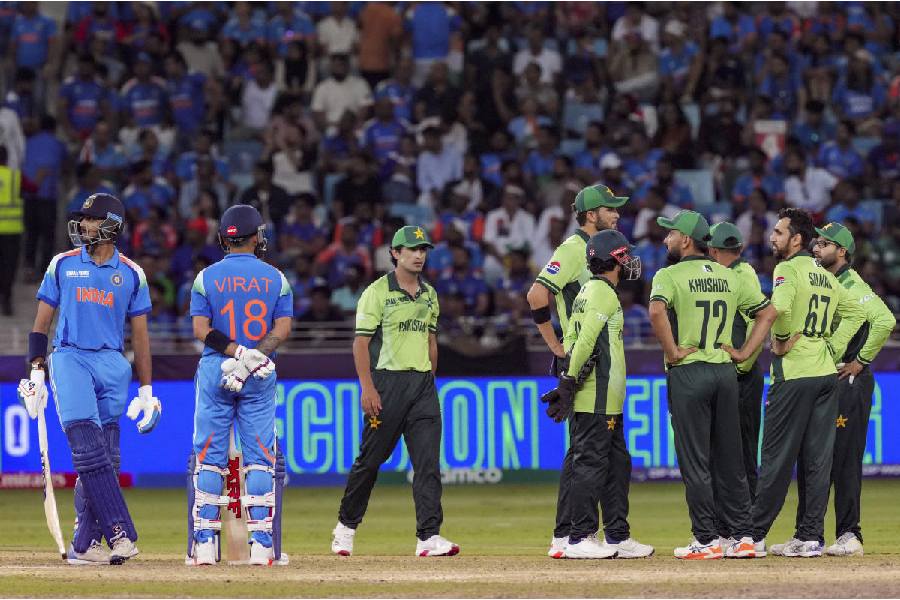
At an age when most boys spend their free time playing video games, Manu S. Pillai was researching away for his first book, The Ivory Throne: Chronicles of the House of Travancore, which he published last year, aged 25. Manu was recently in conversation with writer Jael Silliman at An Author’s Afternoon, presented by Shree Cement and Taj Bengal, held in association with t2, Prabha Khaitan Foundation and literary agency Siyahi.
“My book is about two very strong, interesting, fascinating, somewhat controversial women... and this seems to be the perfect place to be discussing this book, at an event hosted by a foundation named after such an interesting woman,” Manu said, referring to the late Prabha Khaitan. Excerpts...

with Jael Silliman at An Author’s
Afternoon in Taj Bengal
Reality vs history books
Manu: My parents are Malayalis but I grew up in Maharashtra. So, for me Kerala was like a holiday home. But every time we went there, I would see how the history that we were taught in school had nothing to do with the realities of history we saw there.
For instance, in school we were taught that widow remarriage was this great social reform... the plight of Indian women was very generalised. And then I would go home and my grandmother would say, ‘Oh, you know you had a great-great grandmother who was a divorcee in the 1880s...’ and she was a very pious and orthodox woman. But in Kerala, divorce wasn’t a problem.
The matrilineal system gave women lots of privileges and freedoms. She owned property, her husband was kicked out because he wasn’t quite up to the mark....
Then there was this temple in our backyard. It was in ruins because our family went the communist way, much like Bengal, and at one point stopped doing pujas. The stories fascinated me... there are two goddesses, apparently both consecrated in the same temple, but they ‘hate’ each other. One is Durga in her warrior form and the other is Durga in her peaceful form. Every now and then, one of the goddesses runs away from this temple and goes to another temple that belongs to a Brahmin family.... These stories sort of gripped me and I decided that Kerala was definitely worth exploring and investing in. That’s how I began working on this book.
In 2009, I came across the Maharani of Travancore’s private papers, which opened up an entire world of court intrigue and drama, which I thought would make a very compelling setting to tell the wider history of Kerala.

Queen to commoner
The Maharani of Travancore was Sethu Lakshmi Bayi. Here is a woman who became queen of five million people at the age of five. Overnight she’s exalted to a position in a court that’s very orthodox, everything’s protocol-ridden. So, when she walks into a room, everyone stands, nobody talks to her. Her own father doesn’t sit in her presence. Everyone calls her ‘Her Highness’. By 30 she is ruling... unfortunately, she champions not the Hindu elite and the old aristocracy but the entrepreneurial classes — the minorities and the Dalits. Naturally that means her policies aren’t very fashionable with the dominant elites. By the time she’s 40, she’s isolated at court. She loses power to her nephew, who is very much a Hindu consolidationist.
In her 50s, India’s Independence means that the whole of Travancore disappears overnight... wiped out of history. At 62, this woman who has spent all her life as queen and knows no other way of living, gives it all up. She gives away her palaces to the government. Her summer palace becomes an agricultural university, her official residence becomes a medical research facility. She moves to Bangalore and becomes a nobody. She abandons her string of 15 titles and becomes simply Shrimati Sethu Lakshmi Bayi.
In her 80s she dies in Bangalore and is cremated in a queue of dead bodies, like anyone else. So it’s quite a dramatic story of rise and fall.
That court culture was really fascinating because it is a world that does not exist anymore. When she walks into a room, people bow not once but seven times, starting up at the sky and ending at the floor. You’re not supposed to look at her, everyone is supposed to stand away from her so that their breath does not pollute her. When she goes out, lots of guards and soldiers follow her everywhere. She has no privacy.
When I was 19, I thought I’d found a real treasure, because it was worth telling this story. She was a very intriguing character, but so was the ‘villain’, Sethu Lakshmi Bayi’s cousin sister, Sethu Parvathi Bayi.
Seeds of total literacy
Sethu Lakshmi Bayi had so many layers. On the one hand she was orthodox, conservative, always dressed in spotless white, no make-up other than her tika. She was a traditionalist in that sense. But the policies that she put in place are still bearing out in Kerala. Kerala’s literacy rate owes a lot to her, because she put one-fifth of the state’s revenues at the disposal of the education department.
When she came to power, there were no women in government. Within five years, there were 500 women clerks, secretaries... she opened up the legal profession, which is what allowed Anna Chandy to become the first woman legal luminary in the entire Anglo-Saxon world. She went on to become a judge.
She promoted the first filmmaker in Kerala (J.C. Daniel), and in the film, a Dalit woman played an upper-caste role... people would pelt stones at her, but the queen gave her police protection. Not just nurses and teachers, she gave women more jobs and nominated them to the legislature. She was a moderniser in that sense, but personally very orthodox.
 Ravi Varma’s girls
Ravi Varma’s girls
Sethu Lakshmi Bayi and Sethu Parvathi Bayi were born in 1895 and 1896 respectively, and were adopted into the Travancore family. The matrilineal system meant that if the Raja (the queen was referred to as ‘Raja’) didn’t have heirs, he didn’t adopt a male heir, he didn’t adopt sons, he adopted nieces. These two girls were picked by their great aunt, who was the then Maharani of Travancore, and overnight they were exalted to Senior Maharani and Junior Maharani.
Their grandfather was a very charismatic and flamboyant painter, whose name everyone knows — Raja Ravi Varma.
Everyone knows him as the great painter but he was also a political character in Kerala. He was the head of the aristocracy there. He was married to these princesses’ grandmother (who was the sister of the Maharani). Now, his wife wasn’t very aesthetically inclined. She didn’t understand why her aristocratic husband had to work, let alone paint. Because painting was something artisans did, the concept of an artist did not exist. The worst of all was that he accepted payment for his paintings and she was horrified.
But this was the matrilineal system, so as husband he had no status in her home. They started falling apart and he started travelling widely. She took to drink and died of alcoholism and depression at the age of 36. They left behind two daughters, who were the mothers of these two girls.
The feud that began between the couple as a domestic spat came down through their daughters to these girls who became the Maharanis of Travancore. What was a family feud in the 1870s-1880s, by the 1920s became political vendetta, where political coalitions, communities, factions at court were all aligned with one or the other of these two Maharanis.
Their personal vendetta began to affect the lives of five million people. It affected policymaking, decision-making.... southern Kerala as a whole. For me, the idea was also to study this construction of power, the projection of power and the ultimate dilution of power. These two women fought for a generation and at the end of it, Independence came and wiped out their entire world.
In the end they sat up and thought why on earth did we do this, why were we fighting? Both of them ended up dying in somewhat unfortunate circumstances. That was definitely something that interested me as well.
Topless queens
From 19th century onwards, the Rajas became champions of Brahminical Hinduism. Their culture was never like this... women went around topless. Suddenly with the advent of the British and the imposition of Victorian morals, the Raja is told, ‘Oh, your queens walk around topless. How’s this acceptable?’
After that queens started wearing blouses. The Raja commanded all the servants... that women must now wear blouses... but the moment the servants stepped out of the palace, they would cast the blouse aside, declaring that only a slut would want to cover their breasts. No woman of dignity would feel the need to cover her breasts. Only a slut would consider it a sexual object.
But there was an imposition of Victorianism, combined with a patriarchal Brahmanism that started altering all this. The greatest tragedy was when the matrilineal system was abolished... Sethu Lakshmi Bayi was the Maharaja of Travancore because of the matrilineal system. And she is the one that abolished it.
‘THE STORY IS PERFECT FOR A SOAP’
“I was supremely impressed by Manu Pillai’s in-depth research that had gone into the book. He is a fabulous storyteller... wish him all the very best for his journey as an author” — Samrat Datta, general manager, Taj Bengal
“Manu S. Pillai is one of the youngest and most promising authors of India. His seminal work, The Ivory Throne, is a 694-page saga-cum-treatise on the remarkable life of Sethu Lakshmi Bayi, the forgotten queen of the House of Travancore. It’s a gripping story of how a queen became a commoner and faded into obscurity. Manu has laboriously culled archival material and brilliantly presented it to us” — Sundeep Bhutoria, Prabha Khaitan Foundation
“I think The Ivory Throne will make for an interesting read. I am amazed at the research Manu Pillai put in at such a young age! And the story of the royal family of Travancore would make a perfect script for a family drama soap.”
— Manjri Agarwal, foodpreneur
Text: Rupsha Bhadra and Debroop Basu
Pictures: Anindya Shankar Ray
Which is your favourite historical read? Tell t2@abp.in










